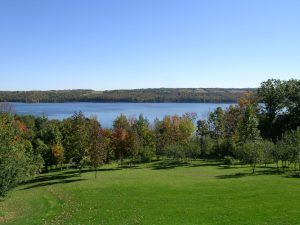 The sight of a woodland lake at sunset or the soft blanket snow over a peaceful country landscape can cause us pause and reflect on nature. After a period of quiet reflection, we move on refreshed. A small inquisitive child might pause to ask, where does the water come from and where will it go? It is not enough for some of us to see. We must observe and know.
The sight of a woodland lake at sunset or the soft blanket snow over a peaceful country landscape can cause us pause and reflect on nature. After a period of quiet reflection, we move on refreshed. A small inquisitive child might pause to ask, where does the water come from and where will it go? It is not enough for some of us to see. We must observe and know.
This same need to know caused an Italian physicist of the 1800’s named Amedee Avagadro to develop something called Avogadro’s number. He determined the actual number of molecules in a gram of any given pure substance. The number of molecules is as 6.023 with twenty-three zeros after it. Let’s apply this number to a known substance, like a glass of water.
Water is a natural resource that is constantly reused. Rain flows into the river, the river flows into an ocean, the ocean constantly evaporates into clouds that once again become rain. When we apply Avogadro’s number to this same glass of water that we drink we realize that this water is composed of so many molecules that have broken apart and reformed that components of the water could have come from anywhere in the world or in time.
The water in the glass you hold could have been the stuff of which dinosaurs were made. It could have been the waves that washed the shores of Galilee when Christ walked the earth. Sand mixed with this water may have made the bricks that built the Pyramid of Cheops. Mixed with natural inks and dyes this water was used to paint the masterpieces of the Chinese dynasties and the art of our local kindergarten class.
The floods of the monsoons in India and the honeymoon vistas of Niagara Falls show the awful power in this glass of water. Hurricane driven thunderstorms destroying all in their paths calm down to the stream you fished as a child. The softly glistening morning dew on the spider web contrasts with the frozen wastes that Perry crossed on his way to the Pole. Water was blended with wood pulp to make the newspapers we read, and the first bible printed on the Gutenberg Press.
Humans are about 92% water and 8% a composite of minerals and trace elements. This glass of water may have been used to make Abraham Lincoln, Leonardo Da Vinci, Einstein, and Madame Curie.
This water in our bodies is constantly recycled as we use about 6 quarts of it in our food and drink each day. Sweat, excrement, moist breath, and tears all contain some of that precious moisture. As possessive as we might think of our water it has been all these things to thousands of generations before and to come.
This glass of water is a reminder of how transient and fragile our existence is. We are here for about 70 years and then we move on, but water is here to stay. Flowing, cooling, refreshing, changeable, formed and static like ice or as shapeless as steam it is as immortal as we are mortal.
Knowing these things, is it right that we take upon ourselves the wanton destruction of the most precious of resources, our lakes? One gallon of gasoline spilled from an old gas tank or lawn mower can spoil one million gallons of ground water. Roadside riparian borders to control run-off are plowed away. Emissions from our power plants have increase the acid content of our lakes 1000 fold effectively killing all life within them. Algae spoils our fishing and swimming. The water we have may not go away, but we can make sure that no other generations will get the use of it if we continue the path we have now chosen.
What can we do? Well, we can realize that there is an answer and it may be sitting in your seat right now. On the first “Earth Day” the slogan was “Think Globally and Act Locally”. So now it is up to us. Well, how about starting today. Think about it when you drink that glass of water. For more information or to join OWLA, visit our website at www.owla.org.
Jon Robson is a member of the Owasco Watershed Lake Association.
Recent Comments